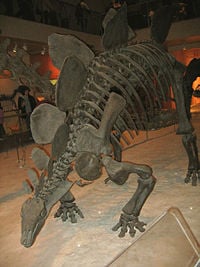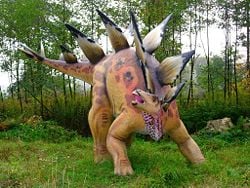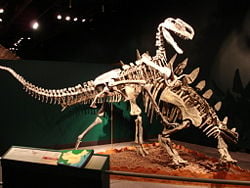Difference between revisions of "Stegosaur" - New World Encyclopedia
Rick Swarts (talk | contribs) (added content on stegosaurus) |
Rick Swarts (talk | contribs) |
||
| Line 23: | Line 23: | ||
}} | }} | ||
| − | + | '''Stegosaur''' is the colloquial name for any of the various plated tetrapods comprising the taxonomic group '''Stegosauria''', a suborder or infraorder of [[Herbivore|herbivorous]] [[dinosaur]]s of the [[Jurassic]] and Early [[Cretaceous]] [[Period (geology)|Periods]], characterized by a double row of bony plates on along the back, hind legs longer than the front legs, a short neck, and a relatively small head. The genus ''[[Stegosaurus]]'', from which the group acquires its name, is by far the most famous stegosaurian. | |
| − | |||
| − | + | Fossils of stegosaurs have been found mostly in the [[Northern Hemisphere]], predominantly in what is now [[North America]] and [[China]]. | |
| − | == | + | |
| + | ==Description== | ||
All stegosaurs have rows of special bones, called '''[[osteoderms]]''', which develop into plates and spines along the back and tail. Many also have intermediate ones, called 'splates'. | All stegosaurs have rows of special bones, called '''[[osteoderms]]''', which develop into plates and spines along the back and tail. Many also have intermediate ones, called 'splates'. | ||
Revision as of 18:06, 14 August 2007
| Stegosaurians
| ||||||||||||||
|---|---|---|---|---|---|---|---|---|---|---|---|---|---|---|
 Fossil skeleton of a Stegosaurus,
National Museum of Natural History | ||||||||||||||
|
Extinct (fossil)
| ||||||||||||||
| Scientific classification | ||||||||||||||
| ||||||||||||||
|
Huayangosauridae |
Stegosaur is the colloquial name for any of the various plated tetrapods comprising the taxonomic group Stegosauria, a suborder or infraorder of herbivorous dinosaurs of the Jurassic and Early Cretaceous Periods, characterized by a double row of bony plates on along the back, hind legs longer than the front legs, a short neck, and a relatively small head. The genus Stegosaurus, from which the group acquires its name, is by far the most famous stegosaurian.
Fossils of stegosaurs have been found mostly in the Northern Hemisphere, predominantly in what is now North America and China.
Description
All stegosaurs have rows of special bones, called osteoderms, which develop into plates and spines along the back and tail. Many also have intermediate ones, called 'splates'.
Skull
They had characteristic long, narrow heads and a horn-covered beak or rhamphotheca, which covered the front of the upper jaw (premaxillary) and lower jaw (predentary) bones. Similar structures are seen in turtles and birds. Apart from Huayangosaurus, stegosaurs subsequently lost nearby premaxillary teeth.[1]
Posture
All are quadrupedal, with hoof-like toes on all four limbs. All stegosaurians after Huayangosaurus have forelimbs much shorter than their hindlimbs. Given that their speed would have been limited by their shortest limb and their size is likely to have precluded them from being bipedal, this suggests that they were not able to run quickly.
Stegosaurus
| Stegosaurus
| ||||||||||||||||||
|---|---|---|---|---|---|---|---|---|---|---|---|---|---|---|---|---|---|---|
 Model Stegosaurus, Bałtów Jurassic Park, Poland.
| ||||||||||||||||||
|
Extinct (fossil)
| ||||||||||||||||||
| Scientific classification | ||||||||||||||||||
| ||||||||||||||||||
Stegosaurus (IPA: /ˌstɛgəˈsɔːɹəs/) is a genus of stegosaurid armoured dinosaur from the Late Jurassic period (Kimmeridgian to Early Tithonian) in what is now western North America. In 2006, a specimen of Stegosaurus was announced from Portugal, suggesting that they were present in Europe as well.[2] Due to its distinctive tail spikes and plates, Stegosaurus is one of the most recognisable dinosaurs, along with Tyrannosaurus, Triceratops, and Apatosaurus. The name Stegosaurus means "roof-lizard" and is derived from the Greek στέγος-, stegos- ("roof") and σαῦρος, -sauros ("lizard").[3] At least three species have been identified in the upper Morrison Formation and are known from the remains of about 80 individuals. They lived some 155 to 145 million years ago, in an environment and time dominated by the giant sauropods Diplodocus, Camarasaurus, and Apatosaurus.
A large, heavily-built and herbivorous quadruped, Stegosaurus had a distinctive and unusual posture, with a heavily-arched back, short forelimbs, head held low to the ground and a stiffened tail held high in the air. Its array of plates and spikes have been the subject of much speculation. The spikes were most likely used for defence, while the plates have also been proposed as a defensive mechanism, as well as having display and thermoregulatory (heat control) functions. Stegosaurus was the largest of all the stegosaurians (bigger than genera such as Kentrosaurus and Huayangosaurus) and, although roughly bus-sized, it nonetheless shared many anatomical features (including the tail spines and plates) with the other stegosaurian genera.
Description
Averaging around 9 metres (30 ft) long and 4 metres (14 ft) tall, the quadrupedal Stegosaurus is one of the most easily-identifiable dinosaurs, due to the distinctive double row of kite-shaped plates rising vertically along its arched back and the two pairs of long spikes extending horizontally near the end of its tail. Although a large-bodied animal, it was dwarfed by its contemporaries, the giant sauropods. Some form of armour appears to have been necessary, as it coexisted with large predatory theropod dinosaurs, such as the fearsome Allosaurus and Ceratosaurus.
The hind feet each had three short toes, while each forefoot had five toes; only the inner two toes had a blunt hoof. All four limbs were supported by pads behind the toes.[4] The forelimbs were much shorter than the stocky hindlimbs, which resulted in an unusual posture. The tail appears to have been held well clear of the ground, while the head of Stegosaurus was positioned relatively low down, probably no higher than 1 metre (3.3 ft) above the ground.[5]
The long and narrow skull was small in proportion to the body. It had a small antorbital fenestra, the hole between the nose and eye common to most archosaurs, including modern birds, though lost in extant crocodylians. The skulls low position suggests that Stegosaurus may have been a browser of low-growing vegetation. This interpretation is supported by the absence of front teeth and their replacement by a horny beak or rhamphotheca. Stegosaurian teeth were small, triangular and flat wear facets show that they did grind their food. The inset placement in the jaws suggests that Stegosaurus had cheeks to keep food in their mouths while they chewed.[6]
Despite the animal's overall size, the braincase of Stegosaurus was small, being no larger than that of a dog. A well preserved Stegosaurus braincase allowed Othniel Charles Marsh to obtain in the 1880s a cast of the brain cavity or endocast of the animal, which gave an indication of the brain size. The endocast showed that the brain was indeed very small, maybe the smallest among the dinosaurs. The fact that an animal weighing over 4.5 tonnes (5 US short tons) could have a brain of no more than 80 grams (2.8 oz) contributed to the popular old idea that dinosaurs were extremely stupid, an idea now largely rejected.[7]
Most of the information known about Stegosaurus comes from the remains of mature animals; however more recently juvenile remains of Stegosaurus have been found. One sub-adult specimen, discovered in 1994 in Wyoming, is 4.6 metres (15 ft) long and 2 metres (7 ft) high, and is estimated to have weighed 2.3 tonnes (2.6 short tons) while alive. It is on display in the University of Wyoming Geological Museum.[8] Even smaller skeletons, 210 centimetres (6.9 ft) long and 80 centimetres (2.6 ft) tall at the back, are on display at the Denver Museum of Nature & Science.
Stegosaurus was the first-named genus of the family Stegosauridae. It is the type genus, that gives its name to the family. Stegosauridae is one of two families within the infraorder Stegosauria, with the other being Huayangosauridae. Stegosauria lies within the Thyreophora, or armoured dinosaurs, a suborder which also includes the more diverse ankylosaurs. The stegosaurs were a clade of animals similar in appearance, posture and shape, that mainly differed in their array of spikes and plates. Among the closest relatives to Stegosaurus are Wuerhosaurus from China and Kentrosaurus from east Africa.
Stegosaurus, one of the many dinosaurs first collected and described in the Bone Wars, was originally named by Othniel Charles Marsh in 1877,[9] from remains recovered north of Morrison, Colorado. These first bones became the holotype of Stegosaurus armatus. The basis for its scientific name, 'roof(ed) lizard' has been thought to have been Marsh's initial belief that the plates lay flat over the animal's back, overlapping like the shingles (tiles) on a roof. A wealth of Stegosaurus material was recovered over the next few years and Marsh published several papers on the genus. Initially, several species were described. However, many of these have since been considered to be invalid or synonymous with existing species,[10] leaving two well-known and one poorly-known species.
Taxonomy
The Stegosauria was originally named as an order within Reptilia by O.C. Marsh in 1877,[11] although today it is generally treated as an infraorder or suborder (or simply a clade) within Thyreophora, the armored dinosaurs. It includes the families Huayangosauridae and Stegosauridae.
The Huayangosauridae were an early family of stegosaurs which lived during the early to middle Jurassic Period. In general, they were smaller than later stegosaurs and had shorter and higher skulls. Currently, the only confirmed genus included is the type genus Huayangosaurus of China. The poorly-known remains of Regnosaurus from England, however, indicate it too could be a member. Its lower jaw is very similar to the former.
The vast majority of Stegosaurian dinosaurs thus far recovered being to the Stegosauridae, which lived in the later part of the Jurassic and early Cretaceous, with one possible genus (Dravidosaurus) from the late Cretaceous. It includes the well-known Stegosaurus. The family is widespread, with members across the Northern Hemisphere and Africa.
Classification

Following is a list of stegosaurian genera by classification and location:
Suborder Thyreophora
Infraorder Stegosauria
- Gigantspinosaurus
- Family Huayangosauridae
- Huayangosaurus (Sichuan,China)
- ?Regnosaurus (Sussex, United Kingdom)
- ?Tatisaurus (Yunnan,China)
- Family Stegosauridae
- Paranthodon - (South Africa)
- Monkonosaurus - (Tibet, China)
- Chungkingosaurus - (Chongqing, China)
- Chialingosaurus - (Sichuan, China)
- Wuerhosaurus - (Xinjiang, Western China)
- Hesperosaurus - (Wyoming, USA)
- Dacentrurus - (United Kingdom, France & Spain)
- Subfamily Stegosaurinae
- Uncertain placement (incertae sedis)
Phylogeny
Kenneth Carpenter of the Denver Museum of Nature and Science published a preliminary phyletic tree[12] of stegosaurs, in the 2001 description of Hesperosaurus. Here, the basal stegosaur Huayangosaurus is used as the outgroup. The Stegosauridae are then defined as all stegosaurs closer to Stegosaurus than to Huayangosaurus. The position of Chungkingosaurus is uncertain due to lack of data.
Stegosauria
|—Huayangosaurus
`—Stegosauridae
`—+-?Chungkingosaurus
`—+--Chialingosaurus
`—+--+—Wuerhosaurus
| `—+--Dacentrurus
| `—Hesperosaurus
`—+--Tuojiangosaurus
`—+--+—Kentrosaurus
| `—Lexovisaurus
`—+--Stegosaurus stenops
`—S. ungulatus (=?S. armatus)
Undescribed species
To date, several genera from China bearing names have not been formally described: Gigantspinosaurus, "Changdusaurus" and "Yingshanosaurus". Until formal descriptions are published, each of these genera is regarded as a nomina nuda.
ReferencesISBN links support NWE through referral fees
- ↑ Sereno, P & Z-M Dong (1992). The skull of the basal stegosaur Huayangosaurus taibaii and a cladistic diagnosis of Stegosauria. Journal of Vertebrate Paleontology 51: 318-343
- ↑ Escaso, F, Ortega, F., Dantas, P., Malafaia, E., Pimentel, N.L, Pereda-Suberbiola, X., Sanz, J.L., Kullberg, J.C., Kullberg, M.C., and Barriga, F. (2007). "New Evidence of Shared Dinosaur Across Upper Jurassic Proto-North Atlantic: Stegosaurus From Portugal." Naturwissenschaften,
- ↑ Liddell & Scott (1980). Greek-English Lexicon, Abridged Edition. Oxford University Press, Oxford, UK. ISBN 0-19-910207-4.
- ↑ Lambert D (1993). The Ultimate Dinosaur Book. Dorling Kindersley, New York, 110–129. ISBN 1-56458-304-X.
- ↑ Carpenter K (1998). "Armor of Stegosaurus stenops, and the taphonomic history of a new specimen from Garden Park Colorado", The Upper Jurassic Morrison Formation: An Interdisciplinary Study. Part 1. Modern Geol., 127–144.
- ↑ Fastovsky DE, Weishampel DB (2005). "Stegosauria:Hot Plates", in Fastovsky DE, Weishampel DB: The Evolution and Extinction of the Dinosaurs (2nd Edition). Cambridge University Press, 107–130. ISBN 0-521-81172-4.
- ↑ Bakker RT (1986). The Dinosaur Heresies. William Morrow, New York, 365-374.
- ↑ Stegosaurus. University of Wyoming Geological Museum. 2006. Retrieved October 6 2006. University of Wyoming Geological Museum
- ↑ Marsh OC (1877). A new order of extinct Reptilia (Stegosauria) from the Jurassic of the Rocky Mountains. American Journal of Science 3 (14): 513–514.
- ↑ Carpenter K & Galton PM (2001). "Othniel Charles Marsh and the Eight-Spiked Stegosaurus", in Carpenter, Kenneth(ed): The Armored Dinosaurs. Indiana University Press, 76–102. ISBN 0-253-33964-2.
- ↑ Marsh, O.C. (1877). "New order of extinct Reptilia (Stegosauria) from the Jurassic of the Rocky Mountains." American Journal of Science, 14(ser.3):513-514.
- ↑ Carpenter, K., Miles, C.A., and Cloward, K. (2001). "New Primitive Stegosaur from the Morrison Formation, Wyoming", in Carpenter, Kenneth(ed) The Armored Dinosaurs. Indiana University Press. ISBN 0-253-33964-2, 55–75.
- Fastovsky DE, Weishampel DB (2005). "Stegosauria:Hot Plates", in Fastovsky DE, Weishampel DB: The Evolution and Extinction of the Dinosaurs (2nd Edition). Cambridge University Press, 107–130. ISBN 0-521-81172-4.
External links
- http://www.palaeos.com/Vertebrates/Units/320Ornithischia/320.200.html
- http://www.kheper.net/evolution/dinosauria/Stegosauria.htm
Credits
New World Encyclopedia writers and editors rewrote and completed the Wikipedia article in accordance with New World Encyclopedia standards. This article abides by terms of the Creative Commons CC-by-sa 3.0 License (CC-by-sa), which may be used and disseminated with proper attribution. Credit is due under the terms of this license that can reference both the New World Encyclopedia contributors and the selfless volunteer contributors of the Wikimedia Foundation. To cite this article click here for a list of acceptable citing formats.The history of earlier contributions by wikipedians is accessible to researchers here:
The history of this article since it was imported to New World Encyclopedia:
Note: Some restrictions may apply to use of individual images which are separately licensed.
